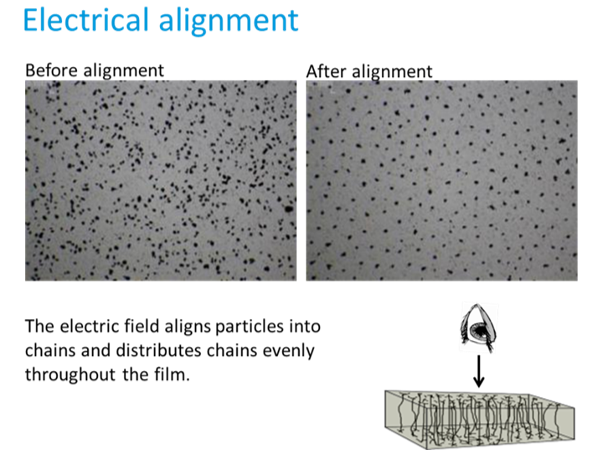They use existing materials and turn them into value products by applying electric fields to arrange particles in polymers.
Physical Mechanism:
The alignment occurs due to dielectrophoresis.
An external electric field induces dipoles in particles
Particle-particle interactions cause chain formation
There must be a difference in relative permittivity between particle and matrix
Interactions can be tuned by changing the electric field parameters
The technology works with a wide range of polymers and particles and particles need not be magnetic, nor conductive.
Control of particle structures in polymer composites allows for numerous advanced product features. Some examples:
- Anisotropic conductive films

- Advanced thermal materials
- Thin film sensors
- Porous membranes
- Transparent conductors
- Mechanical reinforcements
- Structured nanocomposites
- Other anisotropic materials
By customizing electrodes, the technology can target selected regions in a material. They can produce CA-films in layers on top of each other.
- The chains will continue through both/all layers.
- Allows for different properties and particles in each layer, e.g.:
- Skin-friendly / low-cost
- Brittle / flexible
- Sticky / non-sticky
The process is fast, which means the technology can be implemented in high speed production technology. Examples of demonstrated parameters:
Film Thickness: 10 µm – 1 mm
Particle size: “nano” 150 µm
Chain density: 13 000 per mm2 – 500 per mm2
Resistance: < 0.02 Ω – MΩ (through 1 cm2)
Filling fraction: 0.1% – to 70% per volume
Fillers: Metals – Alloys – Nanotubes – Carbon – Alumina
Matrix: Polyurethane – Acrylics – Silicone – Epoxy
Film properties: Hard – Flexible – Stretchable – Sticky – Transparent…
Further optimization possible
Competitive Technology Advantages are:
- Significant reduction in amount of filler particles:
- Lower costs of materials
- Retaining polymer properties (e.g. flexibility, stickiness, transparency)
- Can control particle structures through electric fields:
- Anisotropy / higher uniformity / complex patterns
- Wide range of materials possible:
- Sticky / flexible / hard / soft / transparent films
- Properties can be tuned by materials and process parameters
- Can be implemented in a variety of process technologies:
- Demonstrated roll-to-roll production: quick and cost-effective
CA is working with partners to develop products incorporating the technology and the two that are ideal for electro-mechanical applications are:
- Materials for thermal management
- Anisotropic conductive films for flexible integrated circuits
The above is only a brief. For more information, contact CondAlign+ through their website www.condalign.com or write directly to contact@condalign.no




